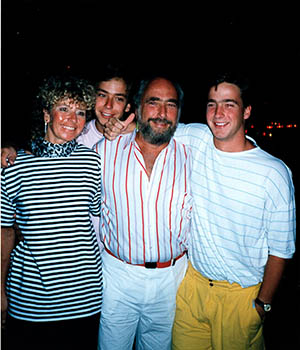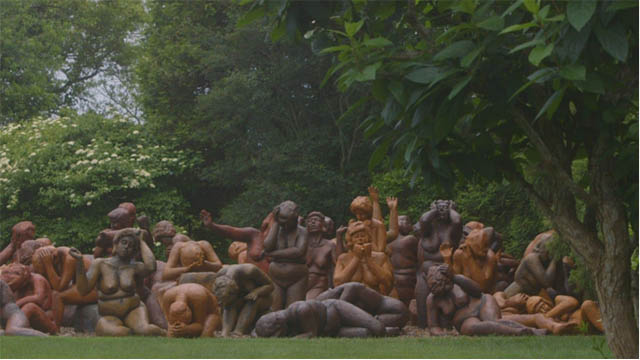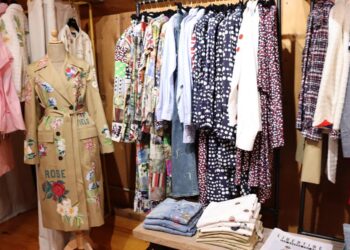Hundreds of families suffered an unthinkable tragedy on December 21 in 1988 when 270 people lost their lives in the bombing of Pan AM Flight 103 over Lockerbie, Scotland. For Montauk-based artist Suse Lowenstein, whose son Alex was killed in the terrorist attack, she immersed herself in her work as a way to cope with his death. Filmmaker Jill Campbell documents Dark Elegy, Lowenstein’s prolific sculpture garden, which encompasses 75 mothers impacted by the devastating day, sculpted in the grief stricken position they dropped to when they heard the heartbreaking news, in Seat 20D, which is screening at Hamptons Doc Fest.
How did you hear of Suse Lowenstein’s Dark Elegy?
JC: My parents actually lived in East Hampton for about 15 years, but then they moved to Florida. I grew up on Long Island, so we vacation every year in Montauk. My husband noticed a blurb in the Montauk Sun about it. He pointed it out to me and we thought it was really interesting and we went and were completely blown away by it, because I’m about the same age as Alex, I went to Ithaca College and he went to Syracuse, I studied in London the year before he was there.
I had a lot of Syracuse friends because Syracuse University and Ithaca College are very close. So, I really knew about this crash and it really affected me deeply. It’s weird, but I always think about it when I’m on a plane. So, when we wandered upon the garden, it just hit me on so many levels. I mean, it hit me on a level of just Suse as an artist and being so open with her grief and with her story and using this to get over her grief, and then it hit me with memories, and it hit me with just how upset I am every time a terrorist attack happens, and how we all just need time to mourn. I feel like Dark Elegy does all of that.
 |
|
The Lowenstein family. (Courtesy Photo) |
I was kind of searching for my next project, and I just kept thinking about it. A couple of weeks later, I got back home and I just called Suse and I asked her if she’d be interested in doing a documentary about the project. There’s been a lot done, there’s another doc about the politics behind the bombing, and there’s been a lot of press on the bombing, and I just kind of really wanted to focus on not the politics behind the bombing, which you could just Google and find, but really on Suse’s story and on how this happened and how it helped her moved through her grief and just the history of the sculptures. At first, she was a little bit reticent, because she’d been through so much and she was tired and tired of the press, and her husband was very sick when I first contacted her. But, we slowly formed a really tight, close relationship, and I kind of earned her trust in the two years that we were filming.
In addition to Suse, you cover a couple of the other families impacted by the tragedy and Syracuse students that were selected to serve as remembrance scholars. How did you decide who else to include?
JC: Again, this is probably the hardest thing, the hardest film I’ve ever worked on because you’re dealing with mothers who lost their children and even 30 years later, it’s still so raw. I kept asking Suse if she would introduce me to some of the other mothers. At first, she was reticent and then she introduced me to Aphrodite, Doris, and Eileen Monetti. She’s good friends with Aphrodite. And Eileen Monetti, Alex was best friends and roommates with her son. Once they agreed to an interview, and again, they were kind of weary after just talking to so much press and it’s still, as you can see in the film, it’s still so raw and heartfelt for them to discuss it. But they were doing it for Suse.
As far as the students, I wanted to interview Tori, who was Alex’s remembrance scholar, and I interviewed Megan, who was Rick Minetti’s remembrance scholar. I just wanted to connect it in a circle, just have everyone connected.
Could you discuss the gravity of bringing the story to the big screen through this perspective?
JC: I think it’s really important for us to mourn with these characters and I think that every time we have a terrorist, mass killing anywhere in the world, we all die a little bit. I feel like the gravity of this is anyone who’s gone through this, either, whether it’s a child they’ve lost from some other tragedy or through a violent ending, they’ll hopefully gain some solace and watching how these mothers met the tragedy head on and survived and persevered to smile today. And yes, they’ll never be healed but they were able to survive and also the way that art helped Suse get through it and she leaned on her art. She says in the film, “I wouldn’t have survived, I would have drank myself to death.” This was how she survived, just the process of creating every single day and that brought her close to her son. I think that the film also really allows an audience to sit there and grieve, grieve for the character, grieve for our present world situation, grieve for all of these massacres that occur all the time. Hopefully, it’s not all depressing, but there’s also some inspiration there too.
As this film does have such a deep connection to the East End, what does it mean to you to be making your world premiere at the Hamptons Doc Fest?
JC: It means so much to me. First of all, it’s where Suse lives. It’s where the sculptures are. It’s where my parents lived for 15 years. I grew up on Long Island in Massapequa. You take a long time and think seriously of where you’re going to premiere your film and I think this is a very strong, powerful festival and I’m honored to be surrounded by documentary giants such as Alex Gibney and Barbara Kopple. It’s very well curated. Also, I feel like this is great because local people in the Hamptons will learn about the sculpture garden. We had a private screening in New York and so many people came up to me afterwards and they were like, “I need to see this.” And Suse loves that. She’s so happy about the film.
Every time you make a documentary, it’s the scariest part or the most anxious ridden part is when you show the film to your subjects, and you never know how they’re gonna react. And she really, really loves the film and she’s been super supportive. I think that it’s just an extension of Dark Elegy. When she says in the film, “It’s a very hard piece to watch, to visit and to take in.” I feel like with the film, it’s the same thing. There’s times that it’s really emotional, emotionally raw, and it’s a hard film to watch. But it’s an important film to watch and it’s hopefully just very reflective of Suse, her journey and the art that she created – this prolific sculpture garden, which is Dark Elegy.
 |
|
Dark Elegy is currently housed in Montauk. (Courtesy Photo) |
Will you and Suse be attending the screening?
JC: Yes. I’m attending, Suse is attending, the cellist Jeanne Fox, our DPs, our producers. We’re all really excited to be there and we will be doing a Q&A.
Now, in the film, it shows the struggles Suse has faced finding a permanent home for Dark Elegy. What is the current status of the sculpture garden?
JC: It’s still in Montauk. It’s open to the public from 10 a.m. to noon, daily, so people can go see it. There’s information on her website www.darkelegy103.com, and my website, www.seat20d.com. She’s still hoping to find a home for it. Maybe she’s hoping through this film, it’ll just shed some light on the project and maybe somebody will become interested.
What are you working on now?
JC: I’m birthing this. I was just a field producer on a documentary about Doc Severinsen. That was directed by Kevin Bright, who created the show Friends. Jeff Consiglio, he co-directed it. He’s an Academy Award winner. I have been working on a doc called The Pink Waves about a woman running for Congress in New Jersey, in the 7th District of New Jersey. We’re getting ready to edit that and then I have a couple of other things in development, but I’m pitching right now. So my plate is full.
I’m also an editor. I freelance and I’m working on some other people’s projects. So, I’m kind of all things doc. My main thing is I create it, direct and produce my own projects, but I love collaborating with other people on their projects as well.
Is there anything else you would like to add?
JC: This is a small independent film. This film was made out of love and passion and my company produced it, but all the artists that worked with me did this out of love for Suse and love for this project and many people just graciously donated their work for this project and made it happen because of the story and how important it is.
Seat 20D can be seen on Friday, December 6 at 12 p.m. at Bay Street.
Bay Street is located at 1 Bay Street in Sag Harbor. For tickets, visit www.hamptonsdocfest.com.






